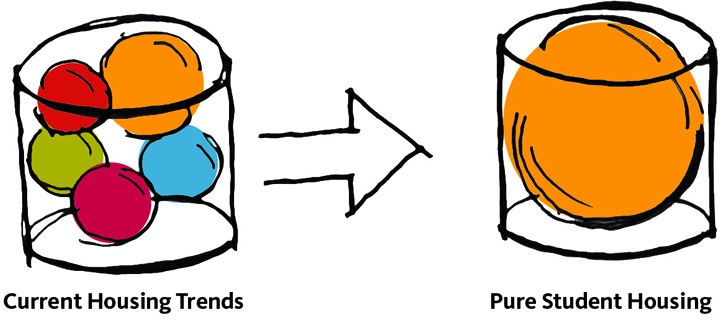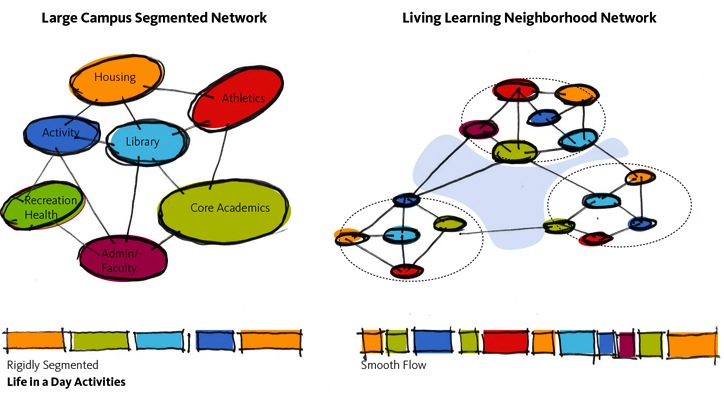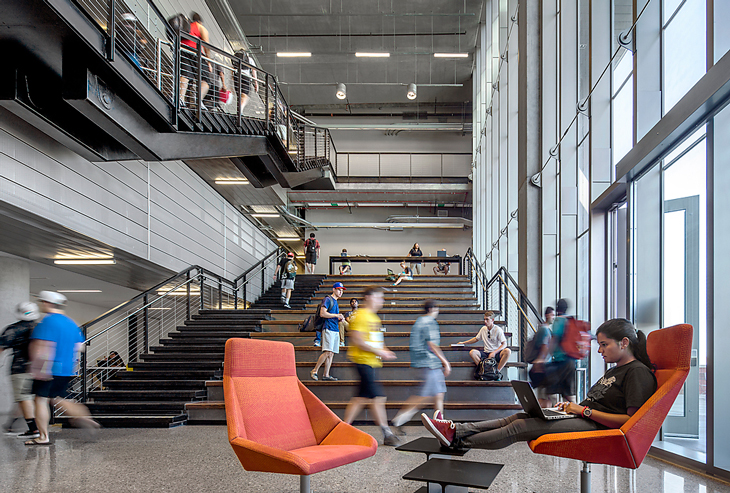The college campus is in a state of change. Flipped classrooms, rising costs, and other factors are forcing universities to redefine the student experience, and housing lies at the center of this constantly evolving equation.
Ongoing Gensler research is focused on campus housing’s integral role in the student experience. Through a series of surveys, student interviews, and data collection, Gensler has developed an understanding of the student experience and its role in helping students’ transition from high school to college. It is clear that space design, furniture solutions, and understanding change management can affect and improve the physical and experiential aspects of student life.
Here are several trends affecting student housing, as well as a design solution ideas that could help campuses better support 21st century students.
Trend #1: Learning Happens Everywhere
The flipped classroom (i.e. the idea that students teach one another in addition to learning from professors) has minimized the role of the lecture hall and helped reinforce the idea that learning happens everywhere on a college campus. This tectonic shift has put a larger emphasis on student living and housing as an integral part of the learning process. Most high performing high school students study in their bedrooms and arrive on college campuses expecting to continue this practice.
This new paradigm for studying presents several challenges. As student housing becomes a place of learning, students often find themselves with nowhere to decompress from the stress of the learning. Rooms used to be places for rest and relaxation. Today they function as study halls. And the presence of roommates and hallmates can make concentrating quite difficult.
Trend #2: Rising Costs Affect All
Student debt and the climbing cost of education is profoundly affecting the student populace. Recent trends in housing have included the rise of mega dorm developments and a focus on creating living arrangements with amenities that rival luxury apartments. Unfortunately the costs of these housing types has driven up living expenses and with it student homelessness.
Too many college students are now left scrambling to find a living space they can afford. Luxury mega dorm developments may have added thousands of beds in self-contained quads to campuses across the country, but these quads are often disconnected from the rest of the campus, creating insular environments. So even as campuses have grown in recent years, the vital connections between dorms and classrooms have been lost.
In response to rising costs, there’s been some push to reduce the size of the dorm room, and in some cases, even revert to an older model of shared rooms and hall style baths. The micro home and shared home are once again relevant in student housing. But as rooms get smaller, public space outside the dorm within the campus network becomes more important in order to accommodate the need for focus space and social space.
These developments have prompted some to question whether campus housing has lost its focus.
Design Solution: Integrated Learning Neighborhoods
Student housing is part of a campus wide network that helps define the success of a student both academically and socially. And as a response to the flipped classroom and need for learning space throughout the campus, most universities are trying to place as much varied programming within dorms as possible. This is being done in order to connect students to the classroom 24/7, but it has resulted in student housing trying to do too much.
 Rather than cram all sorts of programming into student housing facilities, universities should allow housing facilities to remain separate spaces where students can both study and relax. Image © Gensler
Rather than cram all sorts of programming into student housing facilities, universities should allow housing facilities to remain separate spaces where students can both study and relax. Image © Gensler
The solution: Rather than cram student housing with programming that distracts from its overall purpose, create integrated learning neighborhoods that directly link housing with the typical student experience.
Just as urban housing fits into the city as a whole, student housing can be integrated into the campus network as a series of living/learning neighborhoods. As in a city, proximity, convenience, and a sense of neighborhood can allow students to flow more easily between the activities throughout their day, and foster the connections between students and faculty that drive learning and student identity on the campus. By breaking down the scale of the student living experience and understanding each of the pieces on a campus, student performance and health can be better served through the living/learning neighborhood approach.
 Integrated learning networks keep students immersed in the full college experience while saving space and fostering connections. Image © Gensler
Integrated learning networks keep students immersed in the full college experience while saving space and fostering connections. Image © Gensler
Campuses are running out of space for new development and rural campuses are becoming more urban, densifying their limited space resources and trying to integrate a more robust community interaction within the university boundaries. Recent projects have repurposed classroom buildings and office space as new housing. Also, the mixed-use home seeks to integrate housing as part of larger developments on campus.
Whether as part of student centers or larger mixed-use neighborhoods, new developments often seek to combine the favorable economic aspects of student housing with the desire for more integrated campus communities. Doing so can help universities save money and do a better job at preparing students for success in an integrated knowledge economy.
About the Authors: Brian Watson is a designer with a focus on education and community projects that positively transform the learning and life experience. He believes that good design can change people’s lives and set them up for success. Contact him at brian_watson@gensler.com.
Mark McMinn joined Gensler in 1988 and currently helps direct Gensler San Francisco's architecture studio. He focuses on providing innovative solutions in a collaborative client-driven process. Contact him at mark_mcminn@gensler.com.
More from Author
Gensler | Oct 21, 2024
3 surprises impacting the return to the office
This blog series exploring Gensler's Workplace Survey shows the top three surprises uncovered in the return to the office.
Gensler | Jun 26, 2024
5 ways ESG can influence design and create opportunities
Gensler sustainability leaders Stacey Olson, Anthony Brower, and Audrey Handelman share five ways they're rethinking designing for ESG, using a science-based approach that can impact the ESG value chain.
Gensler | May 20, 2024
10 spaces that are no longer optional to create a great workplace
Amenities are no longer optional. The new role of the office is not only a place to get work done, but to provide a mix of work experiences for employees.
Gensler | Apr 15, 2024
3 ways the most innovative companies work differently
Gensler’s pre-pandemic workplace research reinforced that great workplace design drives creativity and innovation. Using six performance indicators, we're able to view workers’ perceptions of the quality of innovation, creativity, and leadership in an employee’s organization.
Gensler | Mar 13, 2024
Trends to watch shaping the future of ESG
Gensler’s Climate Action & Sustainability Services Leaders Anthony Brower, Juliette Morgan, and Kirsten Ritchie discuss trends shaping the future of environmental, social, and governance (ESG).
Gensler | Feb 15, 2024
5 things developers should know about mass timber
Gensler's Erik Barth, architect and regional design resilience leader, shares considerations for developers when looking at mass timber solutions.
Gensler | Jan 15, 2024
How to keep airports functional during construction
Gensler's aviation experts share new ideas about how to make the airport construction process better moving forward.
Gensler | Dec 18, 2023
The impacts of affordability, remote work, and personal safety on urban life
Data from Gensler's City Pulse Survey shows that although people are satisfied with their city's experience, it may not be enough.
Gensler | Nov 16, 2023
How inclusive design supports resilience and climate preparedness
Gail Napell, AIA, LEED AP BD+C, shares five tips and examples of inclusive design across a variety of building sectors.
Gensler | Oct 16, 2023
The impact of office-to-residential conversion on downtown areas
Gensler's Duanne Render looks at the incentives that could bring more office-to-residential conversions to life.
















